
INTRODUCTION
Can you feel it?
We all feel the stress of doing our next endodontic treatment to one extent or another. Why is that?
Stress is present because endodontics is the only dental discipline where we “do it in the dark,” and doing dentistry blind is stressful for any dentist. After entering an endodontic root canal system, we cannot “see” and “do” simultaneously. We lose our precious control. This loss is felt deep in our gut, and our mind agrees. Or maybe it is the other way around. Either way, we have all been there, looking at a pretreatment endodontic image, feeling anxiety and sometimes even threatened. You feel it, your staff feels it, and your patient feels it. It is not fun.
In preparation to receive this article’s full clinical value, I invite you to imagine for a moment that it’s Monday morning and you have found the canal entrance of your first scheduled endodontic patient. At this crucial treatment point, you find yourself experiencing the fear of one or more of the most common endodontic “stress points.” Stress is produced1 because you cannot prepare or preserve the Glidepath for mechanical preparation;2 because the canal is too calcified, coronally restrictive dentin prevents your “following” the canal to length, or you simply “can’t get down”;3 because your mechanical NiTi file could break, stretch, or result in a preparation that you cannot Conefit, 3D clean, and 3D fill;4 from failing to prepare the proper shape for safe and predictable obturation in large or open apex canals;5 from fear of canal blocking, ledging, transportation, or breaking a file in a sharp apical canal hook; or6 because the master gutta-percha cone does not fit after all your effort. Yes, all these things are stressful. They don’t have to be.
These endodontic treatment stress points and concerns are real. What if these stresses could instead be turned into fun, confidence, and successful production? What if a Shaping System allowed you to master your endodontic endgame? What if the stress that you experience while waiting for the final obturation image to appear were replaced with the excitement of anticipating a solid, well-designed obturation with multiple portals of exit visibly sealed? What if, in seeing the final obturation image, your inner child exploded with joy and satisfaction? Allow me to introduce ProTaper Ultimate (Dentsply Sirona). The motivation for creating Ultimate was to transform these endodontic stresses into stressless endodontics. Here is how it was done.
In May 2001, I wrote the introductory Dentistry Today ProTaper article, titled “Introducing a New Rotary System: Progressively Tapering Files.”1 The revolutionary distinction of Shapers (progressive geometries) and Finishers (regressive geometries) was a first and lasting clinical value.2 (Fig. 1) Today, almost 20 years to the day of that first article, I am writing the introductory Dentistry Today article for ProTaper Ultimate – an exploration and assembly of the essentials of endodontic preparation requirements for “appropriate” shaping, 3D cleaning and 3D filling.3,4 Since 2001, ProTaper has saved more than 200 million teeth, 1,200 scientific articles have been written about ProTaper, and ProTaper has become the world’s most popular and recognizable endodontic file system brand. And yet, 2 years ago, it became clear that the endodontic landscape was changing due to further improved metallurgy, cleaning, and filling counterparts.
Fig. 1

ProTaper Ultimate’s goals are to (1) advance minimally invasive endodontics (MIE), (2) simplify the technique, (3) facilitate a safer procedure, (4) treat a wider range of anatomy, (5) start with rotary file first to secure canal, and (6) discover the carefully balanced and essential engineering transition elements from Glidepath through Finisher. The intended result was to design a fresh and almost peaceful clinical experience that fosters fun, predictability, and improved productivity. The most important task of all was to create a desirable Shaping system that dentists would want to use.
ProTaper Ultimate is not just a Shaping System but the first of a 3-part launch from Dentsply Sirona. The first part of this Trifecta is ProTaper Ultimate. Part 2, the 3D cleaning system (SmartLite Pro [Dentsply Sirona]), and part 3, the revolutionary 3D filling system (carrier-based obturation with AH Plus Bioceramic Sealer [Dentsply Sirona]), will be coming soon.
THE ULTIMATE ANSWER TO ENDODONTIC STRESS: THE MAKING OF A “WOW”
When given the opportunity 2 years ago to reinvent a revelatory endodontic Shaping System that would produce a gap between “what is” and “what could be,” we knew the assignment would be an overwhelming invitation since most metallurgies, rake angles, tip designs, sizes, and shapes had been tried in endodontics. Given the enormous success of ProTaper, which is identified as the most recognizable Shaping System in the world, we knew we had a challenge on our hands. ProTaper Gold is also the overwhelming choice of North American endodontists, but could it be made even better?5 Dentsply Sirona designers Dr. Cliff Ruddle and Prof. Pierre Machtou, and I all agreed that if we could not produce a “WOW” (our adopted working title), the project should end. The endodontic world did not need just another file. In fact, since ProTaper’s first-generation launch 20 years ago, there have been an estimated 300 file systems that have come and gone. Their clinical value was not sustainable. In fact, as I am writing this, there are 3 new file system advertisements on my desk promising, at one point or another, everything from total enlightenment to financial freedom. No wonder they come and go. Dentists want to trust that a product does what it promises to do.
Standing still was never a ProTaper option, but the first months attempting to pioneer a WOW felt like standing still. Special things don’t just happen; it is always about intention. Making a WOW took Dentsply Sirona backing; Swiss master engineers Nicolas Crevoisier and Gilbert Rota (the original ProTaper engineer in 1995); an acclaimed machine factory in Ballaigues, Switzerland; craft; passion; patience; vision; and decades of experience. Finally, we needed an additional “creative” ingredient: imagination. Imagination allowed an opening into a future that could forge the fusion of technical precision, uncompromised functionality, and exclusive design augmentation.
In the beginning, the development team was searching for our WOW, but our efforts were all in the wrong places. We were looking for this big WOW, and yet our breakthrough was instead found in many little places. Some believe the relationship between effort and results is not linear and follows what scientists call a “Power Law.”6 According to the Power Law Theory, certain small changes in a complex system can produce exponentially more, and often sudden, results than others. These small changes can cause a cascade among the connected parts, like knocking over the first domino in a long row. We just had to find the right changes. In short, by paying attention to the essential few elements of an endodontic Shaping System, a “less but better” complex was discovered – at last, the WOW we had been looking for. The answer that had been so hard to find suddenly became clear and simple. Certain critical little changes throughout the Ultimate system produced exceptional and expanding performance values.
ProTaper Ultimate has made incredible advancements in the foundational technology for designing, developing, and building an endodontic Shaping System that makes radicular preparations more accessible, more predictable, and more affordable for all dentists. The endodontic transformational power of ProTaper Ultimate was discovered. Time is our biggest cost, and Ultimate’s efficiency and file-robustness result in an endodontic treatment that is energizing and time-saving and frees you to do more. This feeling is deeply rewarding, fulfilling, and gratifying all at once.
NEW FILE FEATURES AND CLINICAL VALUE
The mantra, the sequence, and the ProTaper confidence have always come from a plan for predictability. Look how simple Ultimate makes it: purple, white, and yellow – sculpted endodontic preparations as easy as 1, 2, 3. I will now introduce the entire ProTaper Ultimate family: a simple, wide range of endodontic shaping solutions. (Fig. 2A)
- Slider (purple). (Fig. 2B)
Goal: As always, determine working length. The Slider then prepares a safe, mechanical “Glidepath” for the Shaper. The use of “rotary first” invites you to think profoundly different (both with confidence and caution).
Fig 2A
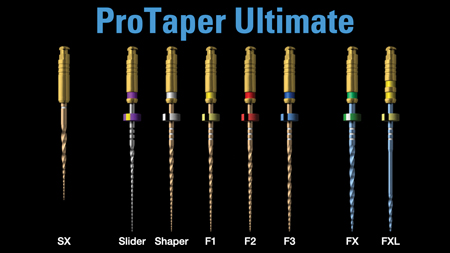
Fig. 2B
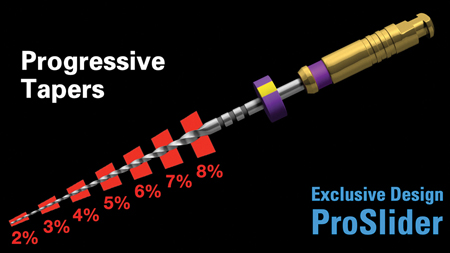
Distinguishing Features and Clinical Value:
- We have thought about the Glidepath differently for some time now.7-10 Nature’s untouched root canal walls often provide a sufficiently smooth tunnel or slide from orifice to physiologic terminus that can be safely followed by this newly designed mechanical file. Simply changing the word Glidepath to “Slidepath” immediately changes a clinician’s mindset and makes the preparation for rotary a much easier game. Nature presents what we now prefer to call “nature’s Slidepath.” Studies show that the Slider can successfully follow nature’s untouched canals ~63% to 80% of the time if we use masterful restraint with professional patience and supreme delicacy (as discovered by the designers and Dentsply Sirona user evaluations). The Slider will find its way by following nature’s natural tunnel, usually in 1 to 3 passive passes, while cradling the handpiece in the palm of your hand. Do not push or peck with your index finger; resist this temptation that will always be present. The index finger is the most dangerous finger in all rotary or reciprocation shaping because it wants to do something, and that something is to push, which leads to breakage, blocks, ledges, transportations, and perforations. If the Slider does not slide after a few self-restrained “follow” passes, return to K-files 6, 8, or 10 and manually prepare a Slidepath.11
- The Slider is a purpose-specific M-wire mix of variable parallelogram cross sections producing enhanced performance vs ProGlider square cross sections.
- Using the Slider at 400 rpm and 5 Ncm vs ProGlider at 300 rpm contributes to enhanced cutting efficiency.
- The Slider’s alternating, offset machining produces reduced friction and greater space for debris removal.
- Shaper (white). (Figs. 2C and 2D)
Goal: Simplify the system by combining 2 Shapers into 1. Integrate ProTaper Gold S1 and S2 in order to design a unique and harmonious transition from the Slider through the Finishers.
Fig. 2C
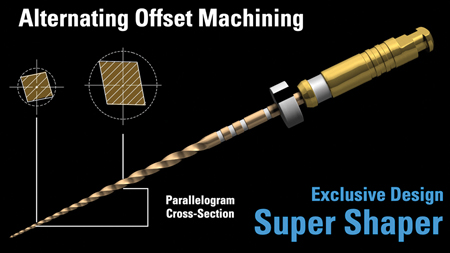
Fig. 2D

Distinguishing Features and Clinical Value:
- The Shaper is a single Shaper.
- The Shaper uses purpose-specific gold heat treatment.
- The Shaper is produced from a 1.0-mm maximum flute diameter (MFD) vs 1.2 mm MFD of ProTaper Shaper S1 and S2, increasing flexibility and preparing an MIE narrower body.
- The Shaper has alternating offset machining and a variable parallelogram cross section generating flexibility without compromising cutting efficiency and resulting in greater resistance to cyclic fatigue.
- Finisher 1 (F1) (yellow).
Goal: Achieve an MIE body while maintaining the iconic ProTaper Deep Shape.
Distinquishing Features and Clinical Value:
- Made from purpose-specific gold heat treatment. (Fig. 2E)
- A 1.0-mm MFD metal vs a 1.2-mm MFD metal, enhancing flexibility and apical preparation control and fashioning a slimmer body shape.
- Alternating, offset machining.
- Carefully balancing better flexibility without compromising cutting efficiency.
- Bernoulli’s principle funnel shapes facilitate 3D filling. (Bernoulli’s principle of fluid dynamics is named after Daniel Bernoulli, who published it in his book Hydrodynamica in 1738.)
Fig. 2E

- Finisher 2 (F2) and Finisher 3 (F3)
(red and blue, respectively, when needed).
The goal, features, and clinical value are the same as with F1. Note that the Slider through the F3 represents the ProTaper Ultimate core. - Auxiliary Finishers FX and FXL (when needed).
Goal: Expand ProTaper Deep Shape preparations with Finishers for larger canals.
Distinguishing Features and Clinical Value:
- Same as F1 to F3, except for 1.2 mm MFD for FX and 1.0 mm MFD for FXL, with purpose-specific blue heat treatment.
- SX Auxiliary Shaping File
(when needed).
Goal: To improve flexibility and preserve superb cutting efficiency.
Distinguishing Features and Clinical Value:
- The new Ultimate SX file, thanks to a variable parallelogram cross section and alternating offset machining, is an auxiliary instrument that combines flexibility without compromising cutting efficiency. This advantage was not the case with the current ProTaper Gold SX version. The new Ultimate SX file has the flexibility advantage of the current ProTaper Gold SX and the cutting efficiency behavior of the traditional, non-heat-treated ProTaper Universal SX file.
- Manual files (when needed).
Goal: Shape anatomy that has an abrupt and sharp apical turn or all anatomy where rotary is not available or not preferred.
Distinguishing Features and Clinical Value:
- Same as rotary counterparts. (Fig. 2F)
- The ability to produce a deep shape and an MIE body with just a few manual and safe rotations.
When comparing ProTaper Ultimate to ProTaper Gold F1 and F2: - Ultimate F1 is 13% more flexible than ProTaper Gold F1.
- Ultimate F1 is 75% more resistant to cyclic fatigue than ProTaper Gold F1.
- Ultimate F2 is 30% more flexible than ProTaper Gold F2.
- Ultimate F2 is 30% more resistant to cyclic fatigue than ProTaper Gold F2.
Fig. 2F
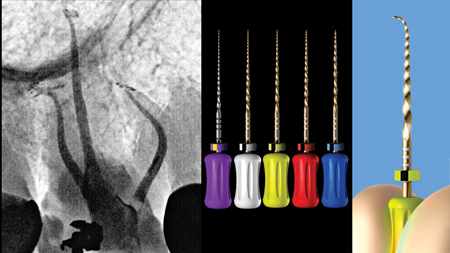
HOW THIS NEW SYSTEM OVERCOMES THE SIX MOST COMMON ENDODONTIC STRESSES
Common Stress Point No. 1:
Glidepath failure.
Ultimate solution: The Slider is intended to be the first instrument to slip and slide down the virgin canal. Fill the chamber with viscous chelator. Cradling the handpiece in the web of your hand (no pushing or “trying” to reach length) allows the file to follow nature’s canal walls to length. (Fig. 3A) If the file slows, remove it, clean the flutes, irrigate with NaOCl or an additional viscous chelator, and repeat until length is reached. If the Slider does not easily progress to length, manually prepare the Slidepath in those last few millimeters. Remember that the Slider reaches length ~63% to 80% of the time, as discovered by the designers and Dentsply Sirona user evaluations. For the other 20% to 37% of the time, return to a manual Glidepath. Please note the newly engineered SX Auxiliary file consistently removes canal access dentin triangles that may prevent easy entrance and apical progression of the Slider. The watchword for the Slider is restraint.
Fig. 3A

Common Stress Point No. 2:
Calcification.
Ultimate Solution: The Shaper is a single Shaper replacing ProTaper’s S1 and S2 Shapers. The Shaper’s reduced MFD and improved cutting efficiency make it easy to remove restrictive dentin along the Slider-prepared walls. It may take several passes while cleaning flutes between passes and irrigating with NaOCl. Finishers will gracefully follow the Shaper’s path. The watchword for the Shaper is patience. (Figs. 3B to 3D)
Fig. 3B

Fig. 3C
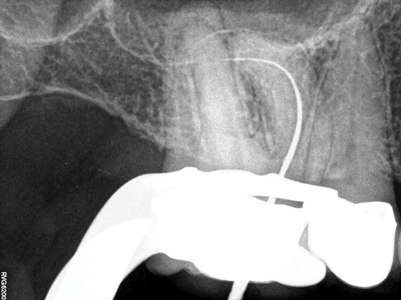
Fig. 3D

Common Stress Point No. 3:
The finishing file breaks or stretches or the prep does not produce 3D cleaning or 3D filling.
Ultimate Solution: As already noted, core Finishers F1, F2, and F3 have more flexibility and greater resistance to cyclic fatigue than ProTaper Gold Finishers. The new design makes them more robust yet highly efficient and produces repeated shapes within the same tooth without metal distortion. This feature produces consistent and accurate Deep Shapes for confidence in 3D cleaning and 3D filling. The watchword for Finishers F1 to F3 and the “Ultimate Look” is effortless. (Figs. 3E to 3K)
Fig. 3E

Fig. 3F

Fig. 3G

Fig. 3H

Fig. 3I
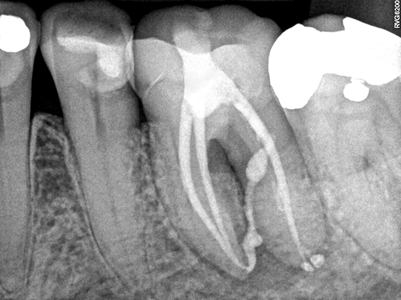
Fig. 3J

Fig. 3K

Common Stress Point No. 4:
Treating larger canals.
Ultimate Solution: The FX and FXL enable clinicians to predictably prepare larger canals where there is sufficient tooth structure. If severe apical reverse architecture is present, an apical plug may be required. The watchword for the FX and FXL is easy. (Figs. 3L to 3N)
Fig. 3L

Fig. 3M

Fig. 3N
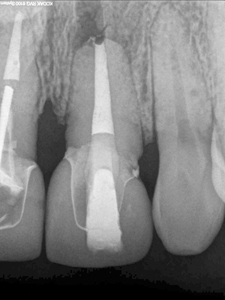
Common Stress Point No. 5:
Fear of breaking a rotary file or blocking, ledging, or transporting sharp apical curvatures.
Ultimate Solution: Manual files have all the same geometries as Ultimate Rotary files and enable the clinician to prepare sharp apical canal curvatures in 1 to 3 turns of the handle. The watchword for Manual files is safety.
Common Stress Point No. 6:
Conefit.12
Ultimate Solution: Precision-machined Ultimate gutta-percha master cones exactly replicate and fit the last 3 mm of the Ultimate apical preparations and are also designed to have an intimate fit throughout the canal preparation, making single-cone, vertical-compaction-of-warm-gutta-percha, and carrier-based obturation easy and predictable. The watch phrase for conefit is conefit is a fit. (Figs. 3O & 3P)
Fig. 3O

Fig. 3P

SIX CARDINAL RULES
Never deviate from these 6 rules; they will always work.
- Always start with the Slider. This allows you to slide down nature’s very own, already existing Slidepath without using a manual file anywhere from ~63% to 80% of the time; otherwise, return to a manual Slidepath. Never force it. Once you have the Slidepath, the rest is easy!
- Always shape the coronal two-thirds of restrictive dentin with the Shaper. This allows you freedom and effortlessness in preparing a Deep Shape apically while preserving pericervical coronal dentin.
- Always finish radicular preparation with the Finisher that cuts apically. If F1 does not visually cut dentin seen in its apical flutes, advance to F2, and if F2 does not visually cut dentin in its few apical millimeters, then advance to F3. If F3 is devoid of apical dentin shavings, then consider FX, and if FX is not cutting dentin on visual inspection, advance to FXL. If the FXL fails to prep the few apical millimeters, then consider an apical barrier due to reverse apical architecture. (Fig 4A) This allows you to prove that you are finished shaping and are ready to confidently fit cone.
- Always conefit after Ultimate flutes are filled with apically carved dentin while the canals are still wet. This allows you to confirm that the Deep Shape and Body Shape are present in your preparation and correspond perfectly with the last finisher used.
- Always use EDTA, then NaOCl 3D cleaning protocol with EndoActivator (Dentsply Sirona) or SmartLite Pro, after conefit. This allows you to remove the smear layer, eliminate tenacious bacteria still present after shaping, and digest remaining pulp.
- Always obturate at the time of shaping unless the patient is symptomatic or if you first want evidence of healing, such as sinus tract closure or endo-perio improvement. This allows you to obturate when you are most knowledgeable and familiar with the root canal system anatomy.
Fig. 4
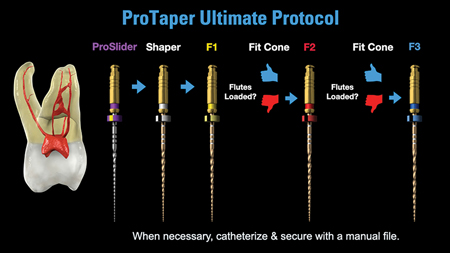
THE ULTIMATE CHALLENGE:AN INVITATION TO DISCOVER FOR YOURSELF
It’s now time for the “Ultimate challenge”: Test ProTaper Ultimate’s performance against your current preferred rotary shaping system (Fig. 4B) by keeping a diary of preparation comparisons – simplicity, efficiency, safety, durability, consistency, predictability, control, and Conefit accuracy and ease the first time.
CLOSING COMMENTS
As dentists, we have the same goals. We are self-selected. We want to help people, we do not want to cause any harm, and we are artists in our own way. We are Michelangelos in a different medium. Even though our desired outcomes are different, our intentions are the same as a Michelangelo sculpture: “Trifles make perfection, and perfection is no trifle.” My purpose in writing this article is to have you experience your own endodontic artistry in your practice through ProTaper Ultimate’s transformational potential.
Twenty-five years ago, the groundbreaking ProTaper concepts were conceived, and in 2001, they were first
embraced by ProTaper advocates in difficult cases, then in easy cases, and eventually in all cases. ProTaper Ultimate is a fresh story in the ProTaper legacy, and, as we venture into the future, I predict Ultimate will be the world’s go-to endodontic-preparation rotary system.
Today is an historical milestone for dentistry as thoughtful endodontic technologies have been brought together to build a generation of dentists free from endodontic stress and serving a greater patient condition. We stand on the precipice of a new era of endodontic performance and experience.
Until the present, “root canal words” such as “tranquil,” “bliss,” and “fun” would never have found their way into mainstream endodontic language. But now, it’s too good and it’s true. Finally, we’re back to my beginning question: Can you feel it?
What are you waiting for?
Oral Health welcomes this original article.
Acknowledgment: Graphics in this article were produced in collaboration with Advanced Endodontics, Santa Barbara, Calif.
Disclosure: Dr. West is co-inventor of ProTaper, ProGlider, WaveOne, Gold Glider, and Calamus products.
References
- West JD. Introduction of a new rotary endodontic system: progressively tapering files. Dent Today. 2001;20(5):50-2, 54-7.
- West JD. The Evolving Look of ‘The Look’. Dent Today. 2019;38(6):62-66.
- West JD. The pendulum swings: “minimally invasive” vs “maximally appropriate.” Dent Today. 2019;38:8-10.
- West JD. The Endodontic Triad: ‘Dead or Alive?’ Dent Today. 2021;28-35.
- West JD. Survey from American Academy of Endodontists. Scientific Zoom Session; April 2021.
- McKeown G. Essentialism: The disciplined pursuit of less. Crown; 2020.
- West JD. The endodontic glidepath: “secret to rotary safety.” Dent Today. 2010;29:86-93.
- West JD. Manual vs. mechanical endodontic glidepath. Dent Today. 2011;30:136-140.
- West JD. Glidepath implementation: “return to the beginning.” Dent Today. 2011; 30:90-97.
- West JD. Restraint: The lost art of endodontics. Dent Today. 2018:100-103.
- West JD. Perforations, blocks, ledges, and transportations. Overcoming barriers to endodontic finishing. Dent Today. 2005;24(1):68-73.
- West JD. The cone fit: An essential step to creating exceptional endodontic obturation. Dent Today. 2005;24(5):102-105.
About the Author

John West received his DDS degree from the University of Washington, where he is an affiliate professor, and his MSD degree in endodontics from Boston University, where he was honored with the Distinguished Alumni Award. Dr. West is founder and director of the Center for Endodontics in Tacoma, Wash, where he is also in private endodontic practice. He can be reached at (253) 377-2007 or via email at johnwest@centerforendodontics.com.










